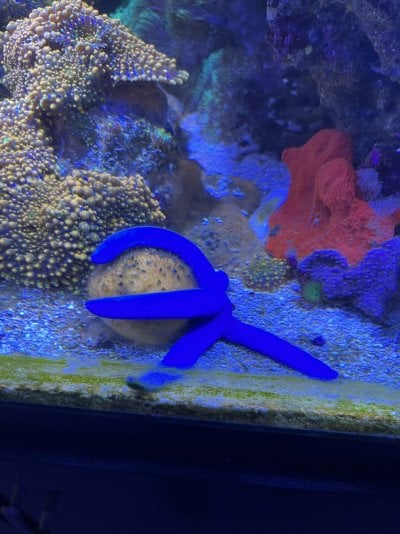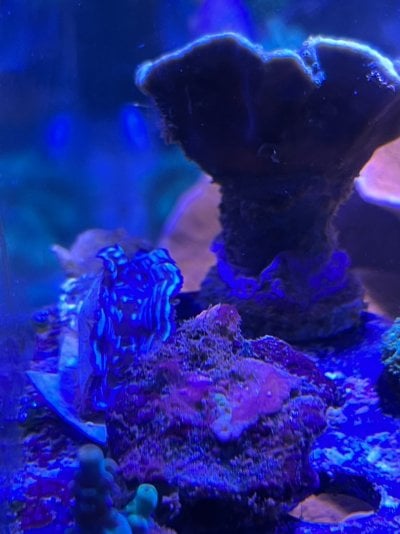I am documenting the progress I have been making with the sea stars in my reef. Once I saw a picture of one eating an Asterina sea star, I wanted to give them a try. However, there are multiple issues when it comes to feeding them. The first issue: are they specialist or generalist feeders? Personally, I believe they are a little of both but further research will be needed. The second issue, and one I believe is missed by many echinoderm novices, they cannot compete with most organisms for food.
After a trip to the store to buy salt, the salesman pointed me to several linckias he had forgotten about in a sump for several months. They all looked healthy and were well past the initial transportation mortality event. One evening, I noticed it was scavenging on a dead anthias after the lights were out. I didn't take out the anthias since it was the first time I had seen it eating but by morning the other inhabitants stole the prize.
I decided to try using Masstick as it worked well for my orangespot filefish. It doesn't float away in the current, and I can place it on anything. I placed Masstick on a coral plug, placed that and the sea star in a floating basket I used to isolate my magnifica anemones. I made several time lapse videos over the year to document how it feeds. The whole process could take up to 12 hours, so I just leave them in there overnight.
I tried the same technique with a Fromia species but was unsuccessful after 3 months. Echinaster tho, seemed to adapt well to this regimen.
Fromia
Echinaster
A few notes to add: while these sea stars have proven to MOSTLY be reef safe, I have noticed a few exceptions. Pineapple sponges and asterina stars are not the only things we keep that they eat. I was keeping a Caribbean yellow ball sponge that kept developing mysterious spots on its surface after the sea star was seen on top of it. This continued until the sponge was completely devoured over several months. However, yellow finger and red ball sponges seem to be off the menu. It also ate what remained of a grafted plating montipora but has not touched the 3/4" baby derasa.
This is not a keeper's guide for sea stars but a kicking off point for what echinoderm care could be like. There's still plenty more to learn about diets for this species and many other species we attempt to keep. Not to mention the special care that has to be considered for interloping tankmates!


After a trip to the store to buy salt, the salesman pointed me to several linckias he had forgotten about in a sump for several months. They all looked healthy and were well past the initial transportation mortality event. One evening, I noticed it was scavenging on a dead anthias after the lights were out. I didn't take out the anthias since it was the first time I had seen it eating but by morning the other inhabitants stole the prize.
I decided to try using Masstick as it worked well for my orangespot filefish. It doesn't float away in the current, and I can place it on anything. I placed Masstick on a coral plug, placed that and the sea star in a floating basket I used to isolate my magnifica anemones. I made several time lapse videos over the year to document how it feeds. The whole process could take up to 12 hours, so I just leave them in there overnight.
I tried the same technique with a Fromia species but was unsuccessful after 3 months. Echinaster tho, seemed to adapt well to this regimen.
Fromia
Echinaster
A few notes to add: while these sea stars have proven to MOSTLY be reef safe, I have noticed a few exceptions. Pineapple sponges and asterina stars are not the only things we keep that they eat. I was keeping a Caribbean yellow ball sponge that kept developing mysterious spots on its surface after the sea star was seen on top of it. This continued until the sponge was completely devoured over several months. However, yellow finger and red ball sponges seem to be off the menu. It also ate what remained of a grafted plating montipora but has not touched the 3/4" baby derasa.
This is not a keeper's guide for sea stars but a kicking off point for what echinoderm care could be like. There's still plenty more to learn about diets for this species and many other species we attempt to keep. Not to mention the special care that has to be considered for interloping tankmates!


















